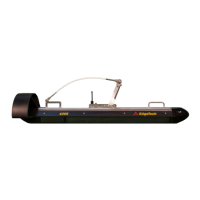7-99
If the above checks do not identify or remedy the problem, attempt to isolate the failure to one of the
major system components: the sonar processor, the modem/power unit, the towfish, or the tow cable.
The following sections provide some specific areas to check and easily identifiable clues to look for in
making an educated guess as to the source of the problem. This is only down to the module or PCB level.
7.9.1 Required Equipment
Except for the topside processor/power unit, only common laboratory test equipment and tools are
required for field troubleshooting. No special equipment is necessary. Typical test equipment includes:
• Digital multi-meter, Fluke, or equivalent
• Oscilloscope
• Hi-pot tester
• Capacitance meter
7.9.2 Transmission Verification
The 4205 Towfish differs from older conventional side scan sonars in that the “listen for the clicking noise”
test cannot be used to verify sonar transmission. Earlier sonars were driven with a high-powered energy
burst that produced a highly audible clicking sound. The 4205 transducers are driven with a low power
smooth rising signal that matches the transducer response. Because of this, there is no pronounced
clicking noise emanating from the 4205’s transducers when they are firing.
Sniffing with an oscilloscope can be used as a substitute to check transducer firing. One way is to attach
the scope probe’s ground to the towfish body and hold the open probe next to the transducer under test.
Set to about 20 to 50mV /Div.
A second method is to connect a several-turn wire loop across the scope probe and move it over the
transducer face. Electrical pickup should be noticed on the scope screen at each transmission burst.
Remember that the transducers and elements within the transducer may be firing together or in
sequence. Make sure that the electrical pickup is not from an adjacent string.
7.9.3 Sonar Processor and Data Link
It is assumed that the sonar processor is up and working on completing system test and troubleshooting.
Refer to the sonar processor’s manual for its troubleshooting and diagnostic information.
The high-speed data connection must also be up and running so that the topside and sub-sea units are
communicating with each other. If the towfish boots up correctly, and passes its internal self-test, there
will be a smooth sequence of rising tones going from 2 to 3.9 kHz. A set of tones jumping from 2 to 3 kHz
means that the self-test has failed.
These tones are generated in the software of the 4205 Towfish and are replicated on the surface when an
EdgeTech topside processor is used to access the Towfish computer subsystem using the Remote Desktop
application. The Self-Test PASS tones repeat until data linkup has occurred between the Topside
Processor, Discover, and the towfish. Self-Test FAIL tones repeat indefinitely.

